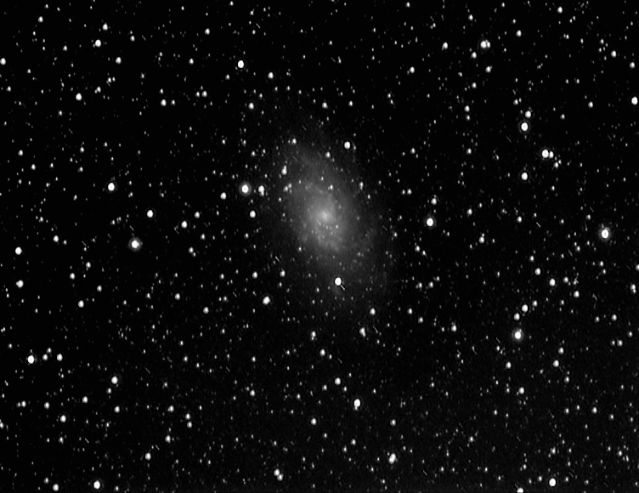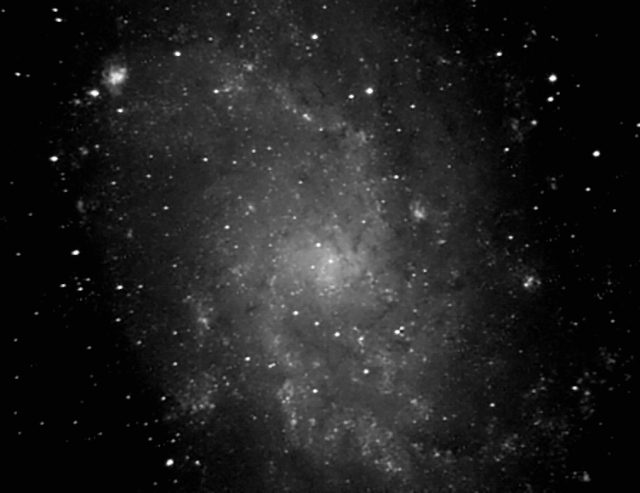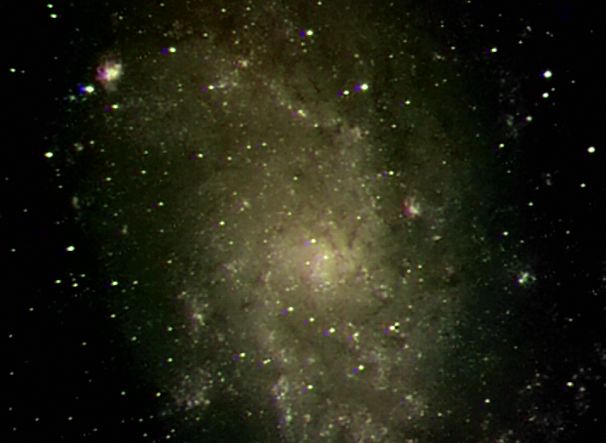 |
M33 captured with a 135 mm SLR lens. The galaxy is about 69 × 42 minutes of arc. The visual magnitude is 5.7 but the surface brightness is only 14.2, so it is quite a faint object.
This is not a good picture for reasons that are quite instructive. Because it is a rather faint object and because of my local light pollution, I used an Orion Skyglow filter forgetting that this does not have good rejection of the infra-red. Unfortunately the optical train I used does not have room for two filters and I was unable to add an infra-red-blocking filter. Undoubtedly the lens is optimised for the visible wavelengths and does not focus the infra-red in the same plane. Consequently this picture includes a significant out-of-focus infra-red component.
Date and Time: 17th January 2010 20.34 to 21:10 UT
Camera: Starlight Xpress MX716
Telescope: 135 mm SLR lens at f/4
Capture: Star_mx7. Exposure 300 sec.
Processing: Star_mx7, background, non-linear stretch power 25, background
Irfanview, conversion to png format.
Registax5, 8 frames stacked
PhotoImpact: focus magic 3,100
|
|
 |
This is a closer view of M33, imaged with my LX200 fitted with a 0.33 focal reducer. The field of view is about 26×20 arc-minutes which is a little too small to show the outer parts of the galaxy
The picture was taken with my MX716 camera in 2×2 binned mode with 120 seconds exposure. After stacking eight images, I enlarged the picture ×2 (to compensate for the binning) and then sharpened it with Focus Magic in its out-of-focus mode. Finally it was reduced to 85% to match the size of the picture above.
Date and Time: 5th December 2012 21.35 to 22:03 UT
Camera: Starlight Xpress MX716
Telescope: LX200 with 0.33 focal reducer and CLS filter
Capture: Star_mx7. Exposure 300 sec.
Processing: Star_mx7, background, non-linear stretch power 25, background
Irfanview, conversion to png format.
Registax6, 8 frames stacked
PhotoImpact: ×2, focus magic 4,100, final reduction to size.
|
|
 |
A month later I imaged M33 again but this time using red, green, and blue filters and I have used these images to add colour to the image above using the LRGB technique. This is the result. I have not calibrated my camera and filter combination which may result in the general yellow tint of the picture. However, if I look at stars that are not saturated in the individual pictures, they are of very similar brightness so are white in the final picture.
Date and Time: 15th January 2013 20.20 to 21:37 UT
Camera: Starlight Xpress MX716
Telescope: LX200 with 0.33 focal reducer and Astronomik RGB filters
Capture: Star_mx7. Exposure 120 sec.
Processing: Star_mx7. Background, non-linear stretch power 25, background
Irfanview. Conversion to png format.
Registax5. 10 frames stacked for each filter
PhotoImpact. Adjutment of size and orientation to match the Luminence image.
RegiStax5. Alignment of the three images and combination to make the RGB image.
Photoshop. Assembly of the LRGB image.
|

